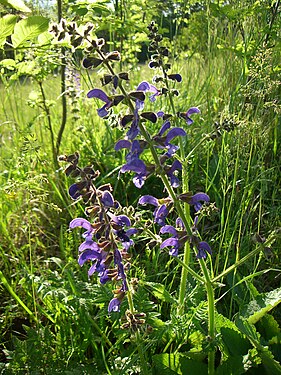Salvia pratensis
| Habit | herbaceous
| |
|---|---|---|
| Height: | ⇕ | 36 in"in" can not be assigned to a declared number type with value 36. |
| Width: | ⇔ | 12 in"in" can not be assigned to a declared number type with value 12. |
| Lifespan: | ⌛ | perennial |
| Bloom: | ❀ | early spring, mid spring, late spring |
| Exposure: | ☼ | sun |
|---|---|---|
| Features: | ✓ | flowers |
| USDA Zones: | 4 to 10 | |
| Flower features: | ❀ | blue, purple, white |
|
Salvia > |
Salvia pratensis (Meadow Clary or Meadow Sage) is a herbaceous perennial in the family Lamiaceae, native to Europe, western Asia and northern Africa. The specific epithet pratensis refers to its tendency to grow in meadows. It also grows in scrub edges and woodland borders.
Salvia pratensis forms a basal clump from 1-1.5 m tall, with rich green rugose leaves that are slightly ruffled and toothed on the edges. The flower stalks are typically branched, with four to six flowers in each verticil. The 1 inch flowers open from the base of the inflorescence, which grows up to 12 inches long. The small calyx is dark brown. The flowers have a wide variety of color, from rich violet and violet-blue to bluish white, and from pink to pure white.[1] The leaves are arranged in opposite pairs, with those on the lower part of the stem up to 15 cm long, decreasing in size higher up the stem.
At one time it was banned from California because it was thought to have naturalized in three locations. Later it was discovered that the real culprit was S. virgata. Both plants are now allowed in California. It is widely grown in horticulture, especially Salvia pratensis subsp. haematodes, which is prized by flower arrangers as a cut flower. Some botanists consider S. pratensis subsp. haematodes as a separate species.[1]
Read about Salvia pratensis in the Standard Cyclopedia of Horticulture
|
|---|
|
Salvia pratensis, Linn. Hardy perennial, 2 ft. or more high: root sometimes tuberous: sts. herbaceous, erect, subsimple, pubescent: lvs., especially in the southern varieties, more or less blood-red maculate; radical lvs. petiolate, oblong-ovate, obtuse, crenate or incised, base cordate, bullate-rugose, glabrous above, pubescent beneath along the petiole and nerves; cauline lvs. few, sessile; floral lvs. cordate-ovate: racemes viscous, subsimple; floral whorls 6-fld., distant; calyx subsessile, campanulate, viscous-villous; corolla bright blue, rarely reddish or white, large, 1 in. long. June- Aug. Eu. Var. alba, Hort., has pure white fls. Var. albiflora, Hort., is a white-fld. form; perhaps this and the preceding are the same. Var. atroviolacea, Hort., has dark violet fls. Var. Baumgartenii, Hort. (S. Baumgartenii, Heuff.), has violet fls. Var. lupinoides, Hort. (S. lupinoides, Hort.), is said to grow 2 ft. high and to have bluish purple and white fls. Var. rosea, Hort. (S. salvatori, Hort.), has rosy purple fls. Var. rubicunda, Hort. (S. rubicunda, Wender.), has rose-red fls. Var. superba, Hort., is offered in the trade. Var. Tenorii, Hort. (S. Tenorii, Spreng.), is said to grow 2 ft. high and to have deep blue fls. Var. variegata, Hort. (S. variegata, Waldst. & Kit.), has light blue fls. with the midlobe of the lower lip white.
|
Cultivation
Propagation
Pests and diseases
Varieties
Gallery
References
- ↑ 1.0 1.1 Clebsch, Betsy; Carol D. Barner (2003). The New Book of Salvias. Timber Press. p. 226. ISBN 9780881925609. http://books.google.com/books?id=NM0iwB8GrQYC&pg=PA226.
- Standard Cyclopedia of Horticulture, by L. H. Bailey, MacMillan Co., 1963
External links
- w:Salvia pratensis. Some of the material on this page may be from Wikipedia, under the Creative Commons license.
- Salvia pratensis QR Code (Size 50, 100, 200, 500)




